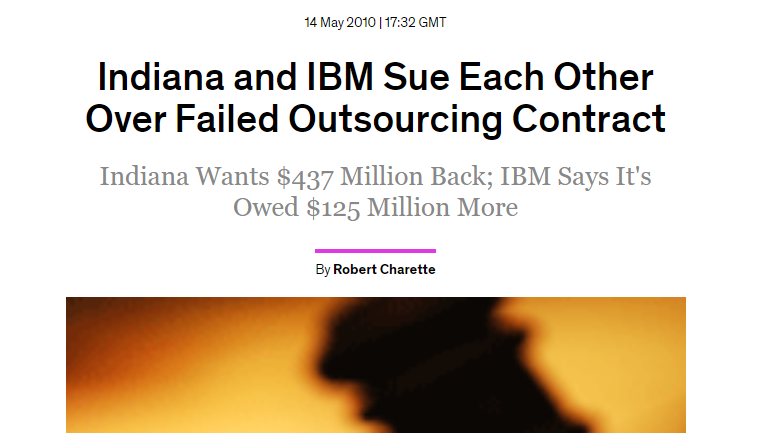The Biggest IT Outsourcing Failures: 7 Examples

Imagine unboxing a gadget you’ve been eyeing for months, only to find it’s nothing like you expected. That sinking feeling? It’s a familiar plot twist in the narrative of outsourcing failures. Not a tale of mere inconvenience, but a series of cautionary episodes that unspool a spool among businesses worldwide.
In this digital tapestry, I’ll decode the mishaps – the vendor reliability issues, the overlooked quality control problems, and those cultural misunderstandings that could unravel a brand’s reputation faster than a click can refresh a page.
You’re in for a revelation as we dissect notable cases where cost-benefit analysis took a backseat, causing more than just economic ripples.
You’ll come away armed with knowledge – a strategic edge carving out robust outsourcing governance models from the specter of hidden costs and data security breaches.
Expect a deep-dive across industries, behind-the-scenes of high-profile ventures, and into the heart of transition management truths.
By the final punctuation mark, you’ll be a step closer to mastering the art of outsourcing, learning invaluable lessons hidden in the folds of outsourcing’s complex fabric.
7 of The Biggest Modern Outsourcing Failures
| Entities Involved | Project and Year of Failure | Key Issues | Financial Impact | Outcome |
|---|---|---|---|---|
| IBM and Indiana | Welfare system, 2009 | Cost overruns, delays, errors | Termination fee of $125 million | Contract terminated |
| Epic and Cambridge University NHS Foundation Trust | Electronic patient records, 2015 | Delays, budget issues | £200 million on incomplete system | Ongoing fixes |
| IBM and Texas | Data center consolidation, 2012 | Overruns, delayed timelines | Over $800 million spent | Restructured deal |
| Cambridge University Hospital NHS Foundation Trust and Medical Software | eHospital system, 2014 | Bugs, staff dissatisfaction | Costs undisclosed | Efforts to fix issues |
| Navitaire and Virgin Airlines | Reservation system, 2010 | Outage, operation disruptions | Compensation costs | Settlement out of court |
| Queensland Health and IBM | Payroll system, 2013 | Errors, overruns | A$1.2 billion costs | Continued with issues |
| IT Vendor and Royal Bank of Scotland | Customer accounts IT, 2012 | Massive IT failure, access issues | £56 million in compensations | Apology, issue rectification |
IBM and Indiana

One of our first failure examples, which serves as a cautionary tale about the hidden costs of outsourcing, is the one that went down between the state of Indiana and IBM. Indiana was looking to outsource the modernization of its welfare processing system as part of its outsourcing strategy.
They were hoping to transform it, reduce costs, fix violations, and introduce a new service delivery model. The goal of the operation, which was worth roughly $1.6 billion, was to allow the system’s users to access and make claims online or over the phone.
Despite having the best intentions and following what they believed were outsourcing best practices, the outsourced final product was chalked full of errors.
Applicants placed frequent claims of long wait times, highlighting outsourcing quality issues. The vendor company needed extra support and, unfortunately, did not get it, leading to vendor management mistakes.
How big of a failure was this? Well, if you do a Google search, you’ll end up with news like this:

Epic and Cambridge University NHS Foundation Trust

Epic, in a bid to outsource service level agreements (SLAs), was hired by the Cambridge University NHS Foundation Trust to develop an online patient record system.
The system was supposed to give staff access to patient records via portable, hand-held devices such as iPads, aiming to improve information flow and performance.
This project was seen as a way to improve staff flexibility through outsourcing, but as we’ll see, it faced its own set of outsourcing challenges.
This project, however, was one of many to fall victim to outsourcing pitfalls and challenges. After the launch of the system, performance dropped 20%. It was known for giving out inaccurate information, which upped the risk of patients not receiving the appropriate necessary care, highlighting the outsourcing quality issues.
Also, the information was not being updated correctly. This led to confusion among the staff as to how to use the new system, emphasizing the communication barriers in outsourcing.
IBM and Texas

The state of Texas, in its bid to improve staff flexibility and reduce costs, was looking to consolidate its data center operations. To complete the task, they chose IBM. Within the first two years of the project, IBM was tasked with consolidating data center operations for 27 state agencies. These agencies were to be divided into two main data centers, a significant outsourcing strategy.
However, within the two years that passed, IBM managed to migrate only the agencies of five systems. To make matters worse, IBM was not performing the nightly backups that their outsourcing service level agreements (SLAs) required.
Through this outsourcing misstep, Texas lost $863 million.
Cambridge University Hospital NHS Foundation Trust and Medical Software

In this case, the goal was to introduce a new way to record patient information. The UK’s NHS, with its history of outsourcing failures, has a record of spending a staggering amount of taxpayers’ money on projects like this – all of which have failed.
The Cambridge hospital hired a US company to create a new system for them. This system was supposed to allow medical staff to access patient records on mobile devices such as iPads. The result of this decision, however, was a 20% drop in productivity, a clear indication of the hidden costs of outsourcing.
The hospital was ill-prepared for how big of a challenge implementing a new system would be. The staff was confused and did not have adequate training to use the system, which is a common problem when introducing new systems to public institutions, showcasing the outsourcing drawbacks.
Navitaire and Virgin Airlines

Navitaire was once responsible for providing Virgin Airlines with an outsource internet booking system, boarding software, and check-in strategy, aiming to improve information flow.
The software, once completed, crashed twice within its first three months, and both times, it took the provider almost 24 hours to get the system back up and operating. This outsourcing pitfall ultimately led to thousands of passengers stuck on the ground and numerous flights being canceled.
Queensland Health and IBM

The health department of Queensland, in an attempt to improve its focus through technology, hired IBM to develop an application for administering payroll.
IBM estimated the cost to be roughly $6 million but soon after placing this estimate, realized that the job was going to be much more work than they had thought, a clear case of outsourcing due diligence gone wrong.
By year-end, IBM had adjusted its estimate to $27 million and, after dragging on for years, the project ended up costing 16,000% more than it was originally supposed to.
In the end, it came in at $1.2 billion and never even worked properly, marking another significant outsourcing failure.
IT Vendor and Royal Bank of Scotland

Although the Royal Bank of Scotland didn’t disclose the vendor that they worked with for what is, perhaps, one of their biggest outsourcing missteps, they did disclose how terrible the situation was, shedding light on the risks of outsourcing.
The bank system required updates and had one planned for June of 2012. It did not go well. This outsourcing pitfall left millions of customers with no access to their hard-earned money, emphasizing the outsourcing challenges that can arise.
Both commercial and non-commercial customers were unable to withdraw funds, perform transactions, or check their balances – and the worst part was that even the bank staff couldn’t do it for them. 30,000 social welfare clients did not receive their money as a result of their failed software update, a clear case of outsourcing drawbacks.
Most Common Reasons for Outsourcing Failures
Too Tight of Deadlines
Trying to complete projects with unrealistic deadlines can mean many areas are skipped over, which ultimately results in a low-quality finished product and a host of issues further down the line, leading to offshoring mistakes.
Sometimes there is no choice but to work within a tight deadline. If you can, however, you make sure to schedule adequate time for every project you outsource. Scheduling a bit of extra time is helpful, as well, to avoid outsourcing pitfalls.
Mismatching Expectations
You and your contractor should be in agreement on the product that is to be delivered to you. Service level agreements, trouble-shooting solutions, and other variables should be discussed and confirmed before the project starts and before any contracts are signed, ensuring proper outsourcing governance.
This ensures that you know what you’re getting and that your contractor knows what they are expected to provide, minimizing the chances of outsourcing missteps.
Lack of Technical Expertise
Software development is usually outsourced as a way for companies to avoid the expensive and often painstakingly stressful process of hiring employees, aiming to improve staff flexibility.
This being said, some companies end up hiring teams that lack the technical know-how that their project requires. When this happens, there are tons of complications that can arise, leading to outsourcing quality issues.
Only Considering Cost
Instead of choosing the lowest bidder, the one who offers the best upfront discount, or the one who offers savings on secondary projects, opt to go with the provider that will deliver you the best quality, avoiding the hidden costs of outsourcing.
You’ll want to consider their previous accomplishments, check out their references, and research the team’s certifications, experience, and professionalism. If you don’t know how to do the necessary research to answer these questions, you can hire a consulting firm to help you make your choice, ensuring you don’t fall victim to common outsourcing pitfalls.
Problems with Code Quality
It can be hard to determine whether your outsourcing team is adhering to the set quality standards while programming your software.
This outsourcing challenge is amplified when you’re working with a team that is a non-tech team that doesn’t have a lot of experience programming, highlighting the potential outsourcing pitfalls related to technical expertise.
Poor Communication
Clients sometimes withhold information because the information seems apparent or obvious – this is one of the biggest outsourcing mistakes that lead to outsourcing failures.
If the outsourcing company doesn’t fully understand its goals, the work will come out differently than you’re expecting, leading to mismatching expectations.
Don’t be afraid to share details with your teams – even those that you feel are blatantly obvious or simply common sense. Communication barriers in outsourcing can be a significant hindrance.
Failing to View the Relationship as a Partnership
When you work with a service provider for the long term, they can become a valuable partner.
If you view your provider in a way that isolates each task they perform for you, it makes it hard to create a strong relationship. Instead, you need to view your relationship as a partnership, ensuring a better outsourcing strategy and governance.
4 Ways to Avoid IT Outsourcing Failures
Determine Your Outsourcing Goals
It’s a good rule of thumb that if you don’t know where you’re going, you’ll never get there.
Once you’ve decided to start an outsourcing venture, you’ll need to decide what parts of your project you want to delegate to other teams. Take some time to think over the skills you have and don’t have, ensuring you avoid offshoring mistakes.
Prioritize Value
Outsourcing most definitely serves as a way to cut costs and lower expenses. However, this shouldn’t be the only or primary reason that you choose to hire an outsourced team for your projects. Outsourcing should never be approached as a cheap way to get rid of work – instead, it should be used to optimize your business, focusing on outsourcing ROI.
This being said, it’s important to focus on value over price, avoiding the hidden costs of outsourcing.
Use A Software Development Agreement
When it comes to doing anything for your business that requires the assistance of an outside party, you should always get the agreement in writing, ensuring proper outsourcing governance.
Software development agreements that are drafted properly can be used as roadmaps for developers to follow, emphasizing the importance of clear service level agreements (SLAs).
They also safeguard you from the effect of losses should things go wrong, providing a layer of risk management.
FAQs about outsourcing failures
Why do outsourcing ventures fail?
It’s usually a cocktail of factors. Communication breakdowns sit at the top, mixing poorly with cultural misunderstandings. Companies often underestimate the effort required in managing third-party relationships, not to mention the hidden costs that creep up. And don’t get me started on when quality control gets benched.
How does communication affect outsourcing outcomes?
Communication is the lifeline. Slip-ups here and you’re asking for it. Missed messages, time-zone tangles, language hurdles, they can all flip a project on its head. Solid communication channels are critical to averting misunderstandings and ensuring that all parties are singing from the same hymn sheet.
Can outsourcing lead to data security issues?
Absolutely, it’s a pulsing concern. Data’s the new gold, right? When it’s in another’s hands, data security breaches can occur. Ensure your outsourcing partner has iron-clad cybersecurity measures. Without solid protocols, you’re just waiting for a leak, and that’s an invitation to a full-blown PR apocalypse.
What role does culture play in outsourcing challenges?
Imagine trying to salsa with someone who only knows the waltz—results are going to be awkward. Cultural differences lead to clashes in work ethics, communication styles, even holiday schedules. It’s pivotal to bridge that cultural gap, or you’re serving up a recipe for disaster with a side of inefficiency.
What are common quality issues in outsourcing?
Quality can take a nosedive if you’re not careful. It’s the lack of expertise that often bites hard, together with poor performance tracking. Companies skim on the due diligence bit and end up with subpar results that couldn’t meet customer satisfaction if it tripped over it.
How do hidden costs emerge in outsourcing?
Look, hidden costs are sneaky. You think you’ve got a sweet deal until additional fees pop up like uninvited guests. We’re talking management overhead, transition expenses, even legal costs due to contractual mishaps. A detailed cost-benefit analysis forewarns of such party crashers, keeping budgets from imploding.
Is outsourcing more prone to failure than in-house efforts?
Not necessarily. But with outsourcing, stakes are high and so is the drama. It’s like wires crossed in a ticking bomb — one wrong snip, poof. Risks of vendor reliability concerns, or supply chain interruptions up the ante. Get your ducks in a row with a sound outsourcing governance model to dodge a fiasco.
What impacts do outsourcing failures have on a company’s reputation?
Reputations hang by a thread here. An outsourcing hiccup can sully your image faster than a viral meme. Customers don’t see supply chain interruptions; they see a brand not delivering. The backlash can be relentless, hurling a once trusted business name into the pits of unreliability.
How can companies learn from outsourcing failures?
Ah, the silver lining! Every gaffe is a lesson served up on a platter. Dig into those case studies; get cozy with the whys of the blunder. Strategic sourcing and refining transition management tactics become bread-and-butter skills. Fumble, learn, refine, and relaunch—it’s the circle of business life.
Are some industries more vulnerable to outsourcing failure?
Sure, it’s not one-size-fits-all. Tech’s a minefield with all the intellectual property concerns and data security shenanigans. Manufacturing’s another one to watch—supply chain mishaps can spin a global web of chaos. It hinges on complexity — the more moving parts, the bigger the ouch when they collide.
Conclusion
And there you have it. A carousel of examples of outsourcing failures; enlightening yet cautionary tales from the crypts of business decision-making. We navigated through the choppy waters of communication breakdowns and dove into the abyss of quality control mishaps.
- We’ve worn the shoes of CEOs who eyed the glittering upfront cost-savings and stumbled upon the hidden boulders of additional fees and management overheads.
- We’ve paced the corridors of ventures derailed by misaligned expectations and cultural dissonance.
- Our journey towards a better grasp of the outsourcing enigma wouldn’t be complete without acknowledging the rough along with the smooth.
Grab these insights by the reins. Let them be your beacon. Now, armed with hindsight — the most impeccable of guides — sculpt outsourcing strategies that are robust, resilient, and, most importantly, attuned to the ethos of your enterprise. Remember, in the grand tapestry of business, even the boldest strokes of venture can be undone by a single loose thread.
If you enjoyed reading this article on outsourcing failures, you should check out this one about nearshoring.
We also wrote about a few related subjects like best countries for outsourcing, outstaffing, outsourcing to Serbia, in-house development vs outsourcing and outsourcing to India.
- What Are Third-Party Cookies and How They Work - April 20, 2024
- How Do Websites Detect Adblock? It’s Quite Simple, Actually - April 14, 2024
- Financial Software Development Companies You Should Know - April 11, 2024








